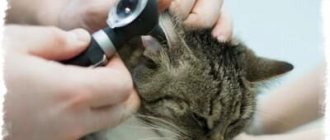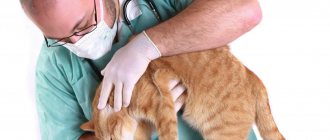Giardiasis in dogs and cats is a protozoal infection that affects many species of vertebrate animals. Cats, dogs and humans are also infected. The infection may be asymptomatic or manifested by diarrhea, malabsorption in the intestine, and weight loss.
Prevalence: Giardia occurs in 5% of healthy cats and dogs, and 15% in clinically ill animals. Young individuals are more often affected. No breed or gender predisposition was identified.
Diagnostics
Diagnosis of giardiasis in dogs and cats
diagnosed based on the detection of motile trophozoites in fresh feces or swabs from the duodenum, as well as the detection of cysts using the flotation method, or Giardia proteins using ELISA. Zinc sulfate solution is the most suitable medium for visualizing cysts (especially after centrifugation), since other solutions can deform them. At least three stool tests should be performed within 7-10 days before giardiasis can be ruled out.
Some ELISA stool testing techniques (eg, SNAP, Giardia Test, Idexx Laboratories) are highly sensitive and easier to use than flotation. Duodenal lumen washes (obtained endoscopically or surgically by injecting the lumen and then withdrawing 5-10 ml of saline) or cytological examination of the duodenal mucosa can sometimes identify Giardia when other techniques cannot. Giardia trophozoites.
Who are Giardia?
It is not a worm, bacteria or virus. Giardia (Giardia) is a single-celled protozoan flagellated microorganism, one of the most common parasites of various animal species (cats, dogs, rodents) and birds.
Man is also on their list. Giardia has two nuclei and two sets of organelles - four pairs of flagella, two medial bodies - everything for simple reproduction by longitudinal division in half, which is what they do. By the way, in the picture these are not eyes, but just nuclei
The body of Giardia is pear-shaped - the front part is rounded and widened, the back part is pointed. The main feature of Giardia is the suction disk on the lower surface of the body. With its help, it attaches to the microvilli of the small intestine and begins to lead a parasitic lifestyle, feeding on the digested food of the host. This is the trophoziod (vegetative stage) of Giardia. It is this form that is invasive, pathogenic, and capable of reproduction. It is very sensitive to external conditions and dies immediately when they change.
Therefore, Giardia also has a second form of existence - cysts . This temporary form is characterized by a protective shell (the microorganism “pupates,” as it were), making it more resistant to adverse factors. Giardia cysts are resistant to low temperatures, but die instantly when boiled. Cysts love moisture; drying them in air for 24 hours leads to complete death. They can live in soil and water for several months. Cysts are resistant to ultraviolet radiation and chlorine.
It is the “cyst” form that serves to “transport” the parasite. Giardia, entering the large intestine from the small intestine, turns from trophosioda into cysts and is excreted along with feces.
Both forms enter the external environment, but only cysts survive!
Treatment
Due to emerging difficulties in detecting Giardia in dogs and cats
(especially if the animal has been treated with antidiarrheal drugs), response to treatment is often a retrospective basis for diagnosis. This approach has its limitations. Quinacrine is effective but no longer available. Metronidazole has few side effects and is quite effective (in approximately 85% of cases, animals recover after 7 days of therapy). However, the response to metronidazole is also evident in animals not suffering from giardiasis. Furazolidone (5 days of therapy) is possibly as effective as metronidazole and is available as a suspension, making it easier to administer to sick kittens. Albendazole (for 3 days in dogs and 5 days for cats) and fenbendazole (for 5 days in dogs and cats) are also effective. According to recent data, ronidazole can also be prescribed. However, none of these drugs are 100% effective, so failure to respond to therapy does not rule out giardiasis.
There are several reasons why it can be difficult to eradicate Giardia. First, giardia in cats and dogs can apparently become resistant to certain drugs. Secondly, giardiasis can be complicated by concomitant diseases or immunodeficiency. Thirdly, there is a high probability of reinfection with giardia, since Giardia cysts are quite resistant to environmental influences and a relatively small number of them is enough to cause reinfection in a dog or person. Regular bathing of the patient and cleansing of the environment can be very important to the success of treatment. Quaternary ammonium compounds and pine resins are effective means for disinfecting premises. Fourth, Giardia can be confused with other protozoa (for example, Trirtrichomonas). Vaccination is generally not effective as a treatment for animals that do not respond to the above-mentioned medications.
Prognosis for cats with giardiasis
With timely medical care, there is a high chance of a complete cure for your pet. If you ignore alarming symptoms, you may lose your animal. To prevent this from happening, it is necessary to systematically undergo examinations and contact a specialist at the first signs of illness. Diagnosis and treatment of a cat should be carried out under the supervision of a veterinarian. In severe cases of the disease, two or even more courses of treatment may be necessary.
It is important to remember that self-medication of a cat, like a person, is unacceptable. Especially in the presence of such a serious disease as giardiasis.
Good to know
- Concentration of vitamins in serum in dogs and cats with diseases of the gastrointestinal tract
- Coronavirus enteritis in cats
- Enemas and laxatives for cats and dogs
- Foreign bodies of the esophagus in cats and dogs
- Campylobacteriosis of dogs and cats (Campylobacter jejuni)
- Abdominal carcinomatosis in cats and dogs
- Volvulus of the mesentery and intestines in cats and dogs
- Clostridia in dogs and cats
- Coccidiosis in cats and dogs
- Constipation in dogs and cats
- Cricopharyngeal dysfunction (achalasia) in dogs and cats
- Coronavirus enteritis of dogs (etiology, signs, diagnosis and treatment)
- Feline infectious peritonitis - FIP
- Infusion therapy for cats and dogs for diseases of the gastrointestinal tract
- Cryptosporidiosis in dogs and cats (etiology, symptoms, diagnosis, treatment)
- Roundworms (roundworms) in cats and dogs
- Infiltrative diseases of the stomach in dogs and cats (neoplasia)
Symptoms of the disease
The first time after the parasite enters the animal’s body, no symptoms are observed. They appear after a time when the number of Giardia in the cat’s intestines reaches a maximum.
The severity of the disease largely depends on the following factors:
- age of the animal;
- state of immunity;
- length of time spent outdoors;
- the size of the infecting dose.
If cats have Giardia, their symptoms may be absent or mildly expressed. As a rule, intestinal disorders are observed, as well as worsening mood or general malaise.
Symptoms of the disease:
- diarrhea;
- the presence of mucus or blood in the stool;
- yellowish or greenish stool;
- deficiency of fats and vitamins during long-term illness;
- allergic reactions;
- vomit;
- weight loss with normal appetite;
- drowsiness, decreased activity.
As a result of blockage of the liver and pancreatic ducts against the background of giardiasis, pancreatitis can develop. In order to avoid serious consequences from parasites, treatment of giardiasis in cats should be started as early as possible.
Prevention
- The first and most important point in the prevention of giardiasis is periodic treatment against external and internal parasites. It is important that the drug you give your pet acts not only against helminths, but also against protozoa.
- Vaccination is an important point if you want to protect your pet from many diseases.
- Correct and balanced diet.
- While walking, do not allow your dog to pick up anything from the ground.
- The dog's area must be kept clean.
Preventive measures
Since Giardia can survive in the environment for a long time, the main preventive method against them is maintaining cleanliness in the house and normal hygiene rules, which consist of the following actions:
- washing hands after cleaning the tray;
- timely disinfection of all surfaces in the house;
- high-quality cleaning of cat habitats;
- treating the cat's tray and dishes with boiling water.
Giardia is very susceptible to a dry external environment, so excessive humidity should not be allowed in the house. In order to avoid infecting your pet with giardiasis, it is necessary to minimize his visits to places where animals frequently gather.
Giardia, which infects humans and cats, belongs to different species, but scientists do not exclude the possibility of humans being affected by Giardia in animals. For this reason, owners of cats with giardiasis should be even more careful about following hygiene rules. Patients with cancer and immunodeficiency need to be protected from the source of infection.
Dog care
Diet
There is no need for any special diet. However, it makes sense to switch your dog to a higher protein diet.
In cases where the gastrointestinal tract has been damaged as a result of the disease, it is worth temporarily putting the dog on a Gastric intestinal therapeutic diet.
Hygiene
During the treatment period, it is recommended to bathe the dog more often. Firstly, because the consequence of diarrhea can be contamination of the fur. And secondly, invasive (infectious) cysts are released in feces. And to avoid re-infection, wash your dog more often.
Metronidazole - dangerous or effective?
Metronidazole is an antimicrobial drug that has antiprotozoal activity. Its mechanism of action is based on blocking the respiratory chain of anaerobes and protozoa with a special nitro group of the drug. This leads to disruption of the respiration processes of microorganisms, which is fraught with death for them. In some cases, DNA synthesis is disrupted, which leads to its degradation. The drug is active against aerobic microorganisms (gram-positive and gram-negative rods) and protozoa.
- Indications for use
- Dosage Recommendations
- Contraindications for use
- Adverse reactions
- Reviews from doctors and people Positive reviews
- Negative reviews
Indications for use
The antibiotic Metronidazole is prescribed for the following diseases:
- Protozoinfections – extraintestinal and intestinal amebiasis, giardiasis, trichomoniasis, cutaneous leishmaniasis, balantidiasis, trichomonas vaginitis and urethritis.
- Infections caused by anaerobic microorganisms - infectious diseases of the peritoneum (peritonitis, liver abscess), damage to joints and bones, pelvic diseases, damage to the nervous system, empyema, pneumonia, bacterial endocarditis, lung abscess, skin damage and sepsis.
- Ulcerative lesions of the gastric region and duodenum.
- Pseudomembranous form of colitis.
The drug "Metronidazole" is prescribed in the period after surgery to prevent the development of infectious complications. For chronic alcoholism, therapy with this medication is also prescribed, which, according to many experts, eliminates the likelihood of a large number of different diseases.
Dosage Recommendations
Metronidazole is available in several forms: powder, suspension, tablets for oral and vaginal use, and solution for intravenous administration. In accordance with the instructions supplied with the medicine, the tablet form of the drug "Metronidazole" should be used after or during meals. The tablets should not be chewed; they should be swallowed with plenty of water.
Recommended dosages of the drug "Metronidazole" according to the type of disease:
Contraindications for use
Metronidazole causes a number of adverse reactions, which mainly occur if a person is treated with this drug in the presence of contraindications. Reviews from patients undergoing therapy contain information that undesirable consequences from treatment also develop if the dosage is not observed. That is why a qualified specialist should calculate the most optimal amount of the drug Metronidazole for effective therapy.
Contraindications:
- individual immunity to components;
- leukopenia;
- damage to the central nervous system;
- renal failure.
The instructions for use include contraindications prohibiting the use of the drug during pregnancy. But taking into account the reviews of doctors, it is with the help of this medicine that helminthic infestations in pregnant or lactating women can be cured
In this case, it is important to correctly calculate the dosage so as not to harm the child and take into account the ratio of benefits for the mother and harm to the baby’s health
We recommend reading: Advantix drops for dogs: instructions for use, reviews, analogues
Adverse reactions
If the recommendations for using the drug Metronidazole are not followed, there is a high probability of developing adverse reactions:
- Digestive system - vomiting, nausea, pain in the abdominal area, constipation or diarrhea, anorexia, dryness and metallic taste in the mouth, pancreatitis, stomatitis.
- Peripheral and central nervous system - dizziness, syncope, headache, sleep disturbance, irritability, increased excitability, depression, convulsions, weakness, hallucinations.
- Hematopoietic system – leukopenia and neutropenia.
- Genitourinary system – cystitis, dysuria, urinary incontinence, polyuria, candidiasis, change in urine color.
Studying the reviews about the drug "Metronidazole" we can conclude that most often during the course of treatment allergic reactions occur in the form of skin rashes, hives and nasal congestion. In difficult situations, chronic rhinitis, arthralgia occurs and fever may appear. When performing an electrocardiogram, flattening of the T wave is observed.
Methods of infection
Dogs become infected with giardiasis orally. That is, when Giardia cysts enter the mouth. Most often this happens when drinking poor quality water.
Since Giardia (in the form of a cyst) is resistant to many disinfectants, and sometimes even chlorinated water (if the concentration is insufficient) does not kill them, you can become infected even by simply drinking tap water at home.
Another common method of infection is when a dog, while walking, sniffs the soil contaminated with cysts.
Also, some dogs have the unpleasant habit of eating the feces of other animals. And if another animal was infected with giardiasis, then there are cysts in the feces. This method of infection is called fecal-oral.











